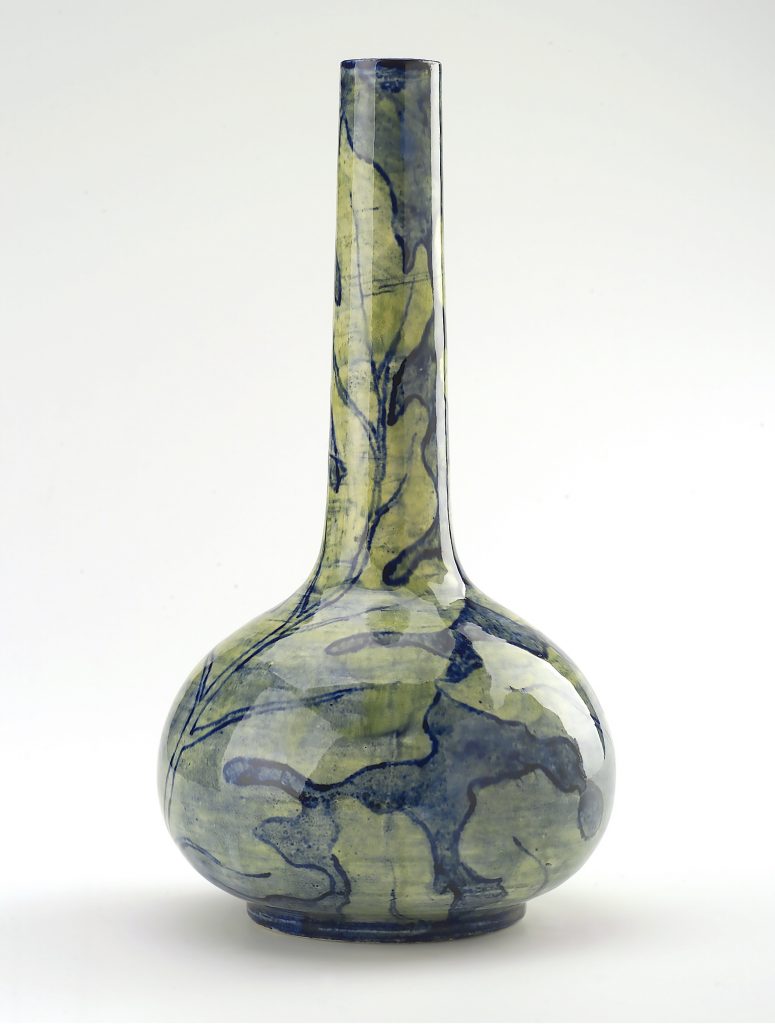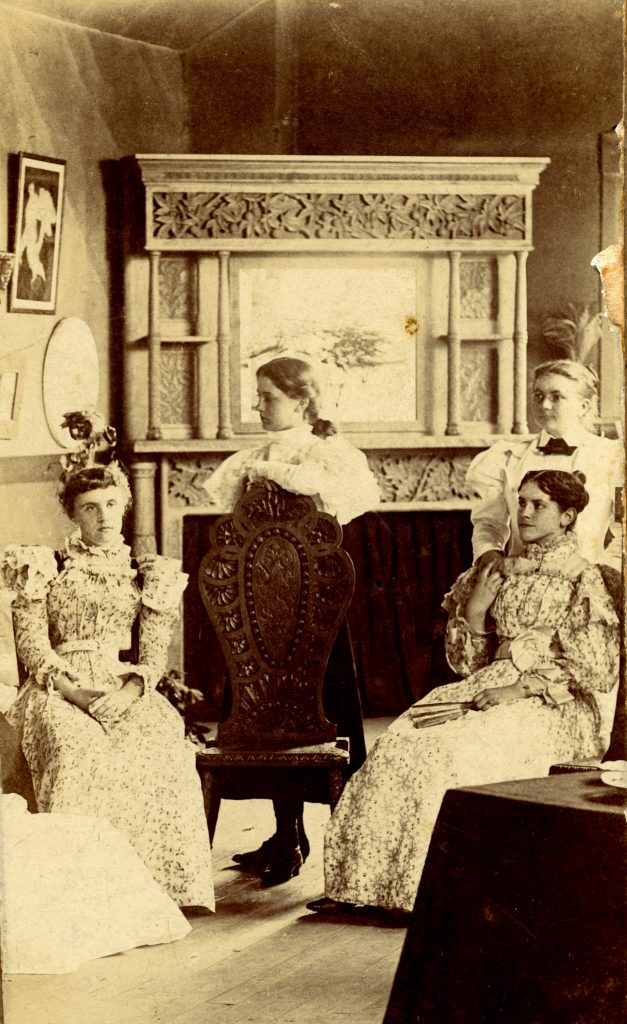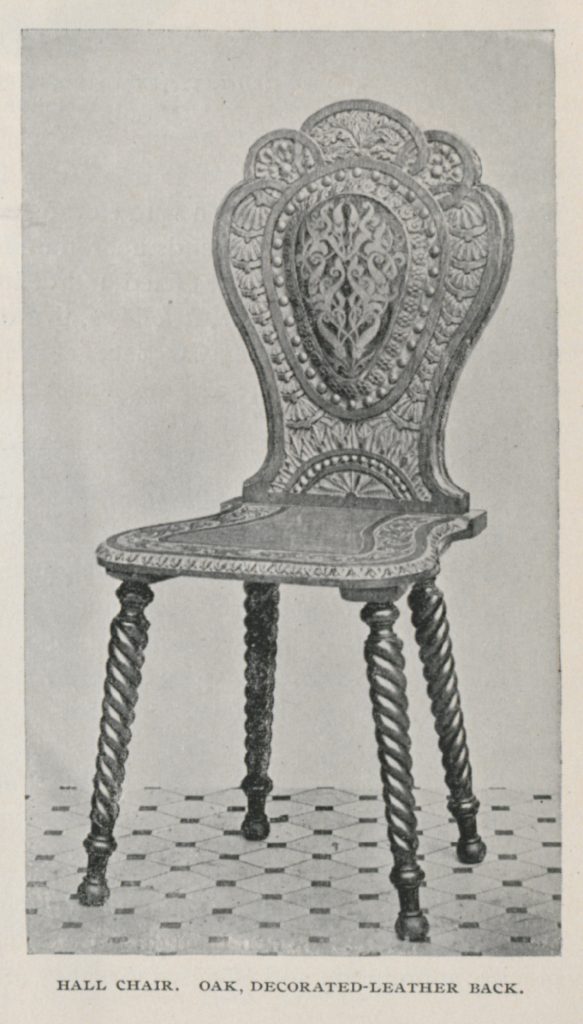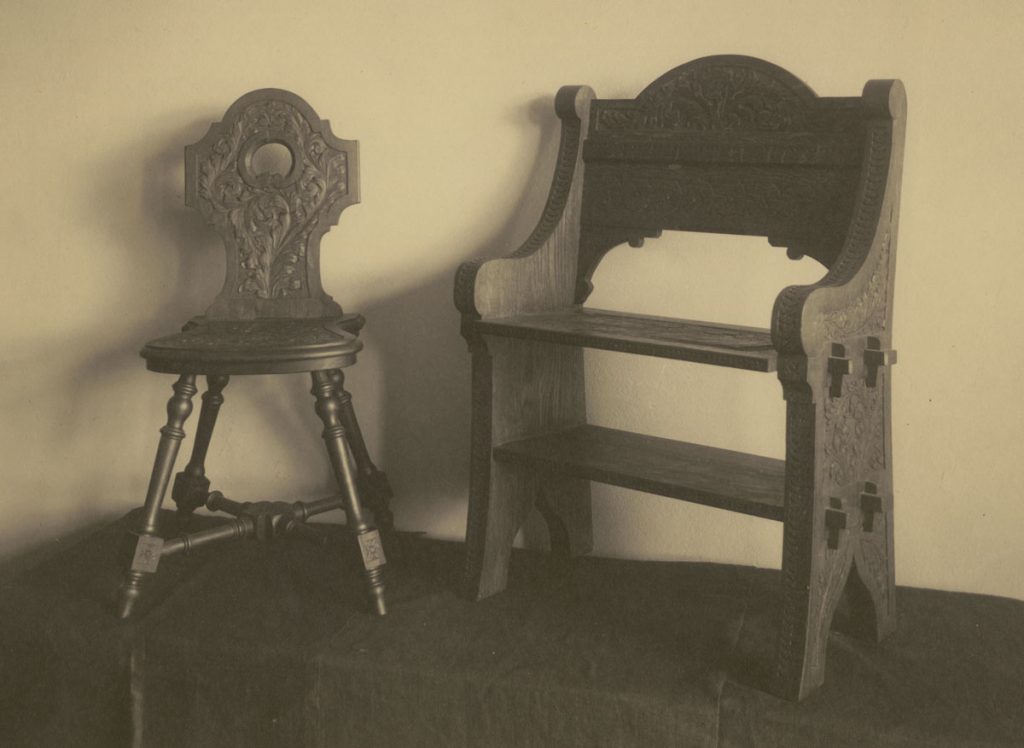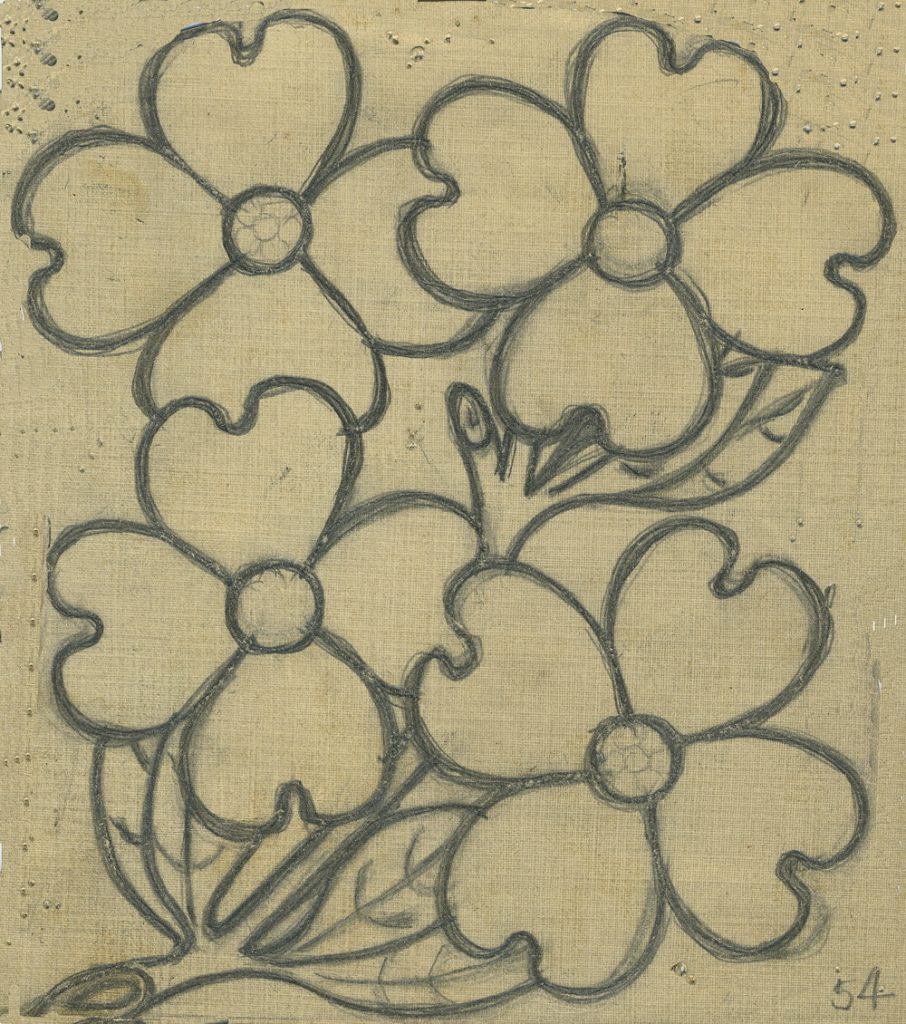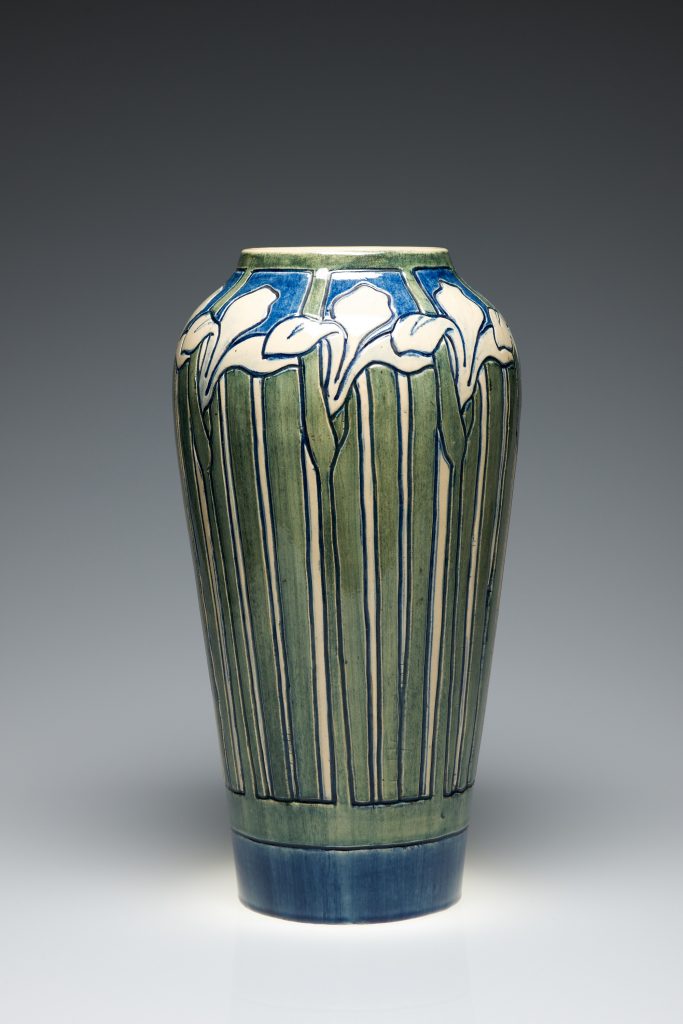Woman’s Work: A Confluence of Education, Design, and Craft
Three objects, produced at three different educational institutions in varying locales within the American South, feature the same treatment of one oak leaf motif: flattened, a bit stylized, and highly linear. In the first, produced at the Newcomb Pottery in New Orleans, Louisiana, by Emilie de Hoa LeBlanc, the design emphasizes the elongated form of a bottle-shaped vase with light green leaves stretching up the neck (fig. 1). In a design for a woodcarving created for the Boys and Girls’ Clubs of Biltmore Parish in Asheville, North Carolina, Eleanor Park Vance portrayed oak leaves flanking a pair of acorns from a flat, frontal position, with a hint of modeling to convey dimension (fig. 2). Finally, the foliage that spreads across the carved mantle behind Mabel Barrow Kreger, photographed while she was a special student at the Stonewall Jackson Institute in Abingdon, Virginia, is similarly positioned, with long, flat leaves separated by thin, curving branches (fig. 3). These visual commonalities hint at connections between the three organizations spread across the Southern United States.
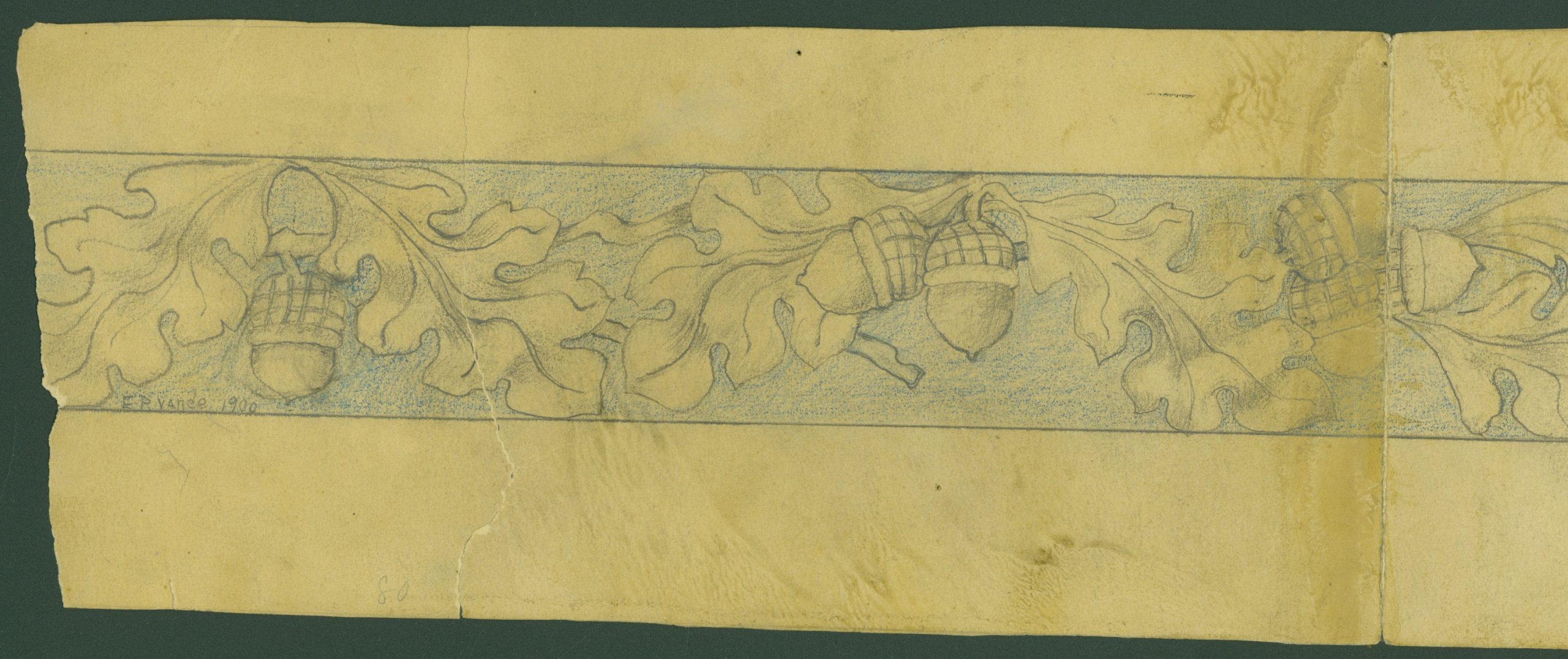
All three organizations were led by women who studied at the Art Academy of Cincinnati, Ohio, and each institution incorporated training in the decorative arts into their curricula in an effort to engender moral and economic uplift among white women and youth in the American South in the late nineteenth century. This essay probes this network of women educators and workers in order to highlight a distinct variety of regional pedagogical and artistic practices that mixed reformist impulses in the arenas of morality, economics, and design. The work done at these schools demonstrates active regional participation in national conversations surrounding education, design, and gender roles during the period.
The Stonewall Jackson Female Institute was established first and emphasized both economic and moral needs within its publications. It was formed in 1867 in the small, Appalachian town of Abingdon, Virginia, by the congregation of the local Sinking Spring Presbyterian Church. The school’s Ornamental Department included instruction in instrumental and vocal music, drawing, and painting.1 The arts were likely originally emphasized as part of a long-standing tradition within Southern women’s education, in which artistic fluency served as an indicator of refinement and wealth.2 In many of the school publications, art also became bound up in the rhetoric of building character. As the 1914 Bulletin explained, “The study of Art has both a practical and an aesthetic value. It forces the student to become observant and accurate, and, increasing a love for the beautiful, aids in developing character.”3 This language relating the love of beauty to an individual’s morality suited the school’s overall mission, “to send from its walls women who have succeeded not only in getting through text-books and culling knowledge from other sources, but in developing character, as well as mind; women who have learned to think for themselves, and to realize their responsibility in life.”4
A potential solution for encouraging character development and fostering financial well-being from the school’s art department was woodcarving. Early in the 1890s, the school’s first woman president, Kate Hunt, hired May Hosbrook (1872–c. 1949) as the art instructor. Hosbrook included woodcarving in the curriculum almost immediately upon her arrival.5 A local newspaper notice, approximately dated to 1894, describes an art reception given by Miss Hosbrook and draws attention to certain student work, including a picture frame made by Kate Hurt and an easel and a jewel box carved by Rosa Rose. The author praises them, stating, “This work would be creditable to the best effort of the best workmen.”6 By the early 1900s, woodcarving courses and products were routinely highlighted in the college catalogues. Later, the woodcarving department became a separate program from art, as its potential for generating income became more apparent. “A school of woodcarving was established at Stonewall over thirty years ago, and became one of the most popular courses in Art, being patronized by students from all parts of the country,” the 1929/1930 catalogue explains. “The carvings made by students are readily salable at good prices. A display room has been arranged for in which carved pieces are on exhibition and for sale.”7 By that point, Mabel Barrow Kreger (1882–1968), who studied with Hosbrook at the institute as a teenager, led the department. She also established her own successful woodcarving studio in Abingdon, the Kreger Craft Shop, which the catalogue may actually reference as the display room.8 Kreger’s achievements as a professional practitioner were rare among Stonewall Jackson students; nonetheless, it was clearly understood by the time of the school’s closure in 1930 that the arts were an acceptable career path for women.
Citizens of New Orleans also faced the problem of finding acceptable employment outside of the home for affluent white women, and it eventually contributed to the 1886 establishment of the H. Sophie Newcomb College for Women, affiliated with Tulane University, which was for men. In the early 1880s, journalists in New Orleans began calling for expanding modes of employment, Catharine Cole (pen name for Martha R. Field) prominent among them. In her weekly articles in the Daily Picayune, she argued that, with the losses of capital caused by the Civil War—as well as the loss of able-bodied and marriage-eligible men and the enslaved labor upon which the regional economy depended—women could no longer rely on fathers and husbands for financial support. Women should therefore be encouraged to find acceptable work outside the home.
Cole’s main goal in her writing was to redefine women’s work to include occupations traditionally held by men; however, “feminine” handcrafts were becoming more widely viewed as a socially acceptable and viable means of work for affluent women. Possibilities for this work gained visibility at the World’s Industrial and Cotton Centennial Exposition, held in New Orleans in the winter of 1884 and 1885. Critics and members of the local media praised exhibitions contributed by women from the Rhode Island School of Design (RISD), the Massachusetts State Normal Art School, and the Art Academy of Cincinnati. These positive responses and evident interest prompted Julia Ward Howe, the Northern poet, abolitionist, and leader who the fair organizers had brought on to helm the Women’s Department, to hire brothers William and Ellsworth Woodward to lead evening and weekend courses in decorative arts for local women. Both were RISD alumni, and William (1859–1939) was professor of drawing at Tulane.9 Their various art courses remained popular after the exposition. When Newcomb College was established shortly after, its founders chose Ellsworth Woodward (1861–1939) to lead the new college art department and consistently referenced the importance of arts education for its curriculum and, specifically, women’s education. “I believe there are features of a woman’s college which can be developed here better than anywhere else, i.e. the modern languages . . . also for the ladies, industrial art and design,” Tulane University President William Preston Johnston wrote in 1887.10
Connecting arts instruction with personal financial solvency did not take long; almost immediately, the school established a four-year Normal Art program for training primary and secondary school art teachers. When Newcomb constructed a new art building in 1894, it included spaces and equipment for courses in painting, sculpture, design, woodcarving, and “the manufacture and ornamentation of pottery.”11 The school hired Mary Given Sheerer (1865–1954), an alumna of both the Art Students League in New York and the Art Academy of Cincinnati, to lead courses in china decoration and design for the 1894/1895 academic year. According to her writings, experiments with clays and glazes were conducted that winter, with a color palette selected from the results. Students who finished the Normal Art course were then admitted into the pottery program the following year, and the commercial enterprise known as the Newcomb College Pottery officially began.12 From Woodward’s substantive purchases of ceramic-making materials in 1891 to the rapidity of the pottery’s development between 1894 and 1896, it is apparent that adding another potential avenue for students to earn money from their art was a goal for administrative figures soon after the college’s establishment.13
The Daily Times-Picayune celebrated the ceramic arts program in comments about the college exhibition of painted china and pottery at the end of its first year, proclaiming that “the advantage of this new field which has been thrown open to the women of Louisiana cannot be estimated.”14 In addition to this positive local reception, Woodward and Sheerer successfully promoted the pottery among a circle of significant New England and Chicago collectors and in national publications, drawing widespread acclaim, which only grew after the Newcomb College Art Department received a bronze medal for its display of thirteen vases of the pottery in the Department of Varied Industries at the Exposition Universelle in Paris in 1900.15 Building on these successes, the college constructed a building specifically for the pottery in 1902. That year, the school also added coursework in embroidery, and instructor Mary Williams Butler began experimenting with metalwork.16 These goods were available for purchase in the salesroom at the pottery concern, as well as through local and national retail agents. While Newcomb designers rarely earned enough to support themselves completely, its administrators’ efforts to provide training for women in the industrial arts signifies the potential they saw in it for resolving the economic challenges faced by white, affluent women in New Orleans in the 1880s and 1890s. The pottery operated until 1940, after waning enthusiasm and financial strife, amplified during the Great Depression, led Newcomb to end the commercial venture.17
Stonewall Jackson and Newcomb College represent specific contributions to the formal education of a particular class of women in the South and the development of affiliated industries to serve their economic needs. The Biltmore Estate Industries, the last of the three institutions in this study to be established, presents a different approach. In this instance, an organization devoted to extracurricular education, which claimed to focus on moral development, quickly transformed into an economic enterprise. In 1901, Eleanor Park Vance (1869–1954) and Charlotte Louise Yale (1870–1958) relocated with Vance’s mother to Biltmore Village outside Asheville, North Carolina, for the older woman’s health. Vance and Yale met at the Moody Bible Institute in Chicago and worked in settlement houses around the city; in Asheville, they turned to the Church of All Souls to continue mission work. Vance studied woodcarving at the Art Academy of Cincinnati for two years, from 1888 to 1890, and then returned for another year in 1895. The details of much of Yale’s artistic training remain a mystery, but she largely focused on weaving, music, and ceramics.18 Seeing the local boys’ interest in Vance’s woodcarving hobby, the two women formed the Boys’ Club of Biltmore Parish as an organization devoted to the activity, with its main objective of “the bringing of boys together for mutual help and development.” Vance wrote in 1901, “Wood carving has a disciplinary value which has been very noticeable with the boys, for it requires not only development and training of the muscles of hand and arm but mental effort as well since every touch of the chisel must be guided by thought and intelligence.”19
Aided by a booming tourist market in Asheville, the Boys’ Club quickly evolved into a craft industry, selling small articles to tourists who visited its classes. By 1904, they were filling Christmas orders by mail. The club also benefited from a close relationship with Edith and George Vanderbilt, who provided financial support and patronage, as well as a ready supply of discounted materials from the Biltmore Forestry Department. The demand inspired the Girls’ Club of the parish, which previously focused on needlework and millinery, to request access to woodcarving classes, and the two clubs merged. In 1905, the clubs’ leaders organized the Biltmore Estate Industries. This group focused on manufacturing articles for sale, thereby concentrating on local economic development. With the founding of the Biltmore Estate Industries, the Boys’ and Girls’ Club primarily served as a social unit and training grounds, with those who mastered their craft in the club going on to work for Biltmore Industries.20
After George Vanderbilt’s death in 1914, Fred Seely purchased the craft industry and eventually eliminated the woodcarving program in favor of its more commercially successful wool weaving business. Vance and Yale had already moved further south to Tryon, North Carolina, and established a new club, the Tryon Toy-Makers and Wood-Carvers, which again focused on children.21 Unlike with the Boys’ and Girls’ Clubs, which were first formed to strengthen character before evolving into an exercise in economic uplift by happenstance, the pair seem to have planned for combined moral and economic uplift from the inception of this second project. Not long after starting the new endeavor, they built a small house for displaying the children’s toys and other objects, in order—according to Allen Eaton’s account in Handicrafts of the Southern Highlands in 1936—“to accommodate the increasing trade.” Eaton’s list of the Tryon Toy-Makers’ products includes the type of small objects that had been enthusiastically received at the Biltmore Estate Industries: “old Florentine, as well as modern and indigenous designs in picture frames, book-ends, nut bowls, fireside benches, tea trays, footstools, bellows, hearth brushes, and so forth. Massive Gothic benches as well are made by these young workers who will also fill special orders in wood carving to meet specific needs.”22 Although Vance and Yale eventually sold the company in the 1950s, it continued to produce toys for a national clientele into the early 1990s.
Unlike most of the other Appalachian craft groups that Eaton documented, the Tryon Toy-Makers did not fit the parameters of folkways preservation that he and other authors had come to expect. During the late nineteenth and early twentieth centuries, a number of individuals started organizations that aimed to maintain craft traditions perceived to be native to the region’s people—a term that in this context was applied equally to those residents of Anglo-Saxon descent and Native Americans in the region. These revivals of folk crafts reflect the influence of John Ruskin’s calls for a return to preindustrial methods of manufacture.23 They also have parallels with contemporary progressives’ encouragement of European craft traditions in the name of social uplift at urban settlement houses, like those where Vance and Yale first worked.24
While Southern Appalachian craft revivals were driven by similar impulses, they were also attuned to economic need. For example, Dr. William Goodell Frost’s efforts to revive weaving at Berea College in Kentucky paired efforts to preserve a supposedly preindustrial way of life with securing finances for the college, as New England donors enthusiastically purchased students’ homespun coverlets. Likewise, Frances Goodrich established the Allanstand Cottage Industries in North Carolina in 1895 in order to preserve local weaving traditions and to provide a means of income for the rural women who were the subject of her Presbyterian mission work. Both figures emphasized crafts that were viewed as traditional by the New England and Midwestern consumers with whom they were familiar.25 Stylistically, objects made at the Stonewall Jackson Institute and the Biltmore Estate Industries reveal that their makers were more connected to metropolitan centers and design movements than suggested by this emphasis on folk revivalism. The three organizations in this study present a related, but different approach to engendering moral and economic uplift, one that combines handcraftsmanship with modes of design training typically associated with modern industrialization.
Significantly, each of the three organizations had a founding figure who studied at the Art Academy of Cincinnati, one of the early institutions devoted to industrial design education in the United States: May Hosbrook, who led Stonewall Jackson; Mary Given Sheerer, who taught at Newcomb; and Eleanor Park Vance, who founded the Biltmore Estate Industries. Hosbrook took woodcarving classes at the art academy from 1885 until 1888, and again in the 1889/1890 school year.26 Her Stonewall Jackson students completed a mahogany panel for the screen for the pipe organ at the Cincinnati Music Hall in 1896.27 Sheerer likely attended the art academy around the same time as Hosbrook. Although she spent much of her youth in New Orleans, Sheerer returned with her mother and sisters to her native Covington, Kentucky, after her father’s death in 1883; Covington’s close proximity to Cincinnati, just across the Ohio River, would have facilitated Sheerer’s attendance.28 Finally, Vance studied woodcarving at the art academy from 1888 until 1890 and returned for additional classes in 1895.29
Founded in 1869 as the McMicken School of Design, the special aim of the Art Academy of Cincinnati was “the improvement of the Industrial Arts, by spreading among the operative classes of this city a more thorough technical and scientific education in Art and Design, as applied to manufactures, so as to aid them in obtaining that taste and skill in the fashion and finish of their work, whether large or small, which always commands the preference.”30 Woodcarving classes began in 1873, led by Benn Pitman (1822–1910). Pitman learned the craft from his daughter Agnes (1850–1946), who had taken lessons with another local woodcarver, William Fry (1830–1929). Pitman’s classes at the academy were immensely popular. Pitman and Fry’s students exhibited together at the Centennial Exposition in Philadelphia, receiving national acclaim for their designs.31 Their work also drew great attention at the Cotton Centennial Exposition in New Orleans in 1884/1885 and directly inspired Ellsworth Woodward’s decorative arts classes in the city during Newcomb College’s foundational period.32
Instead of favoring industrial design education or handcraft, the Art Academy of Cincinnati merged the two, encouraging the application of principles of the former in the execution of the latter. The school’s aforementioned dedication to “the improvement of the Industrial Arts” echoes the language used by British design reformers in the nineteenth century who advocated for changes to prevailing design modes in manufactures in order to improve the quality of British goods and more readily compete in swiftly expanding markets. American design reformers understood that training students in the mechanisms of the manufacture and design principles of objects could similarly improve the quality of American products. Numerous schools followed British design reform pedagogy that insisted on remaining faithful to materials and their construction, steering away from copying historical precedents, and utilizing nature to inspire decoration.33 One can see these influences in the list of books that Pitman donated to the Women’s Art Museum Association of Cincinnati. The titles include compilations of essays espousing ideas in this vein, including Art-Studies from Nature, As Applied to Design: For the Use of Architects, Designers, and Manufactures (1872).34 However, Pitman also lectured and published extensively on John Ruskin, who fervently believed in the superiority of handcraftsmanship, and he praised Ruskin’s insistence on art’s moral obligation. Pitman did not necessarily see his woodcarving classes as a very fruitful occupation for women. While a vocal advocate for women’s artistic pursuits, he stated that he intended to provide an “interesting and useful occupation to girls during the period intervening between leaving school and marriage, and mainly with a view to the decoration of their own homes.”35
In spite of Pitman’s ideas, artistic education was embraced as a palatable solution to providing women with a livelihood, especially within the context of postbellum economic strife and diminishing reliability upon men for financial support. Although women were rarely able to maintain lasting, financially viable careers as artists, the significance of the academy in opening different educational paths for women should not be diminished. Particularly in the case of women such as Hosbrook, Sheerer, and Vance, graduates of the Art Academy of Cincinnati educated new generations in their respective crafts. This, in turn, either evolved into practicable trade occupations or provided the necessary credentials for teaching careers. Combining the interests embedded in their Art Academy of Cincinnati training—of refining design for economic ends and championing the power of handcraftsmanship for moral uplift—Hosbrook, Sheerer, and Vance served the needs that they perceived of their Southern students and built successful institutions focused on women’s education. In fact, works from all three institutions were exhibited at the Jamestown Ter-Centennial Exposition in Norfolk, Virginia in 1907, where, in the Department of Manufactures and Liberal Arts, the Stonewall Jackson Institute received a silver medal, and the Art Department of Newcomb College won a gold.36
Besides its pedagogical impact, the stylistic influence of the Art Academy of Cincinnati on these three Southern institutions is seen when comparing their works with those of Pitman’s students in Cincinnati. As might be expected because of their shared medium, woodcarvings from Stonewall Jackson and the Biltmore Estate Industries exhibit the strongest relationships. The chair at the center of the photograph of Stonewall Jackson students (fig. 2) is markedly similar to one that appears in a photograph in Benn Pitman’s “A Plea for American Decorative Art,” a pamphlet printed for the Cotton States and International Exposition in Atlanta in 1895 (fig. 4).37 Foliage in a central oval, flanked by full flowers in loops, top both chairs’ balloon backs, and half-flowers, likely daisies or asters, fill small curved panels that descend down the chair backs’ sides, leaving a cartouche in the center. Another flower rises from the back’s joint with the seat on each, an arch of beading separating the center from radiating petals. Although the seat is less visible in the Stonewall Jackson photograph, it appears to have similar carving around its edges as well. Related panels of foliage, carved in low relief, are pictured on a bench and hall chair by the Boys’ Club, dating to around 1904 (fig. 5). Similarly, Vance and her students’ designs also gesture toward various levels of stylized forms, executed in low relief. Some of the most heavily delineated designs, such as those for bookends (fig. 6), seem equally suitable for application as a repeating motif on a piece of Newcomb Pottery (fig. 7). Setting aside other outside influences, these aesthetic relationships point to the significance of the Art Academy of Cincinnati as a nexus for this network of women educators in the South.
These organizations’ programs emerged in the last quarter of the nineteenth century, shortly following or alongside similar efforts in major metropolitan centers in the United States, such as Candace Wheeler’s New York Society of Decorative Arts (founded 1877). Their emergence indicates the level of concern regarding the state of design in the United States during this period, as well as a regional desire to redress an uncertain economic future in the South. Ellsworth Woodward implied as much when speaking of the establishment of the Newcomb College art program and its priorities:
True service to a community lies in providing education for its young people. There was, as yet, no place for artists or designers. During three generations a conquered people, Southerners had established a momentum of thought which did not include art. So first we must give the girls a chance to prove art a practical matter, related to the world of affairs.38
As Woodward observes, “the girls” were charged with the task of demonstrating the relevance of the arts for economic development, through the creation of objects more conspicuously related to industry and commerce.
By introducing Newcomb College Pottery, Biltmore Estate Industries, and Stonewall Jackson Institute as examples of educational institutions established and nurtured by and for women in the South in the wake of the Civil War, this essay has shown how New Orleans, Asheville, and Abingdon became active centers of design education. A closer examination of their curricula and products may reveal additional threads running between regional and national design and pedagogy that will help expand the field of Southern art history. By taking women’s work seriously, we might see a little flowering of H. L. Mencken’s infamous “Sahara of the Bozart.”39
Cite this article: Elyse D. Gerstenecker, “Woman’s Work: A Confluence of Education, Design, and Craft,” Panorama: Journal of the Association of Historians of American Art 6, no. 1 (Spring 2020), https://doi.org/10.24926/24716839.9862.
PDF: Gerstenecker, Woman’s Work
Notes
- Lewis Preston Summers, History of Southwest Virginia 1746–1786, Washington County, 1777–1870 (1903; repr. Baltimore: Regional Publishing, 1979), 573. ↵
- Christie Anne Farnham, The Education of the Southern Belle: Higher Education and Student Socialization in the Antebellum South (New York: New York University Press, 1994), 48–49, 66–67. The continued inclusion of ornamental classes in upper-level education was often seen outside of the region as evidence of Southern women’s academies’ poor-quality curriculum and old-fashioned manners. ↵
- “Stonewall Jackson College Bulletin, 1914–1915,” facsimile, Tadlock Collection, E. W. King Library, King University, Bristol, TN. ↵
- Catalogue of Stonewall Jackson College (Bristol, TN: LeRoi Press, 1907–8), 22. ↵
- “Stonewall Jackson College: From an Address Delivered by Mary Lynch Sanders Beamer,” Bulletin of the Historical Society of Washington County, VA, 18 (1951), 1, facsimile in the exhibition file for Her Wooden Canvas: The Carvings of Mabel Barrow Kreger, William King Museum of Art, Abingdon, VA; and Mary Alice Heekin Burke and Amy L. Miller, “Biographical Index of Cincinnati Woodcarving Students, 1873–1925,” in Cincinnati Art—Carved Furniture and Interiors, ed. Jennifer L. Howe (Athens: Ohio University Press, 2003), 247. Because the exact identity of May Hosbrook requires further research and clarification, I have not included birth and death dates for her. Burke and Miller listed Hosbrook’s entry in the Art Academy of Cincinnati catalogues as May “Mayme” W. Hosbrook and her residence as Brough/Blue Ash, OH, which is in Sycamore Township. They identified her parents as Mahlon and Sarepha Hosbrook. The 1900 United States federal census lists a Mayme Hosbrook as an artist, born in 1866, living with her parents Mahlon and Sarepta Hosbrook in Sycamore Township, OH. Previous census records refer to her as Mary. This census also documents a May Hosbrook, born around 1871, living with her parents John and Alice, in Sycamore Township, OH. Mary Hosbrook, born 1866, married Blair W. Kincaid in 1903 and died in 1968 in Kansas City, MO. May W. Hosbrook, born 1872, was a public school teacher for most of her life and died in Cincinnati, OH, in 1949. ↵
- “Jackson Institute,” unidentified, undated newspaper, c. 1894, exhibition file, Her Wooden Canvas: The Carvings of Mabel Barrow Kreger, William King Museum of Art, Abingdon, VA. ↵
- Stonewall Jackson College Annual, 1929–30 (Abingdon, VA: Stonewall Jackson College, 1930), 43-45, Historical Society of Washington County, Virginia, Abingdon, VA; and Catalogue of Stonewall Jackson Institute (Bristol, TN: LeRoi Press, 1907–8), 7, Library of the Virginia Museum of History & Culture, Richmond, Virginia. The 1907–8 catalogue notes Miss Margaret Kelly as the art instructor at Stonewall Jackson. This is most likely Margaret Buchanan Kelly (1871–1947), who was born and raised in Abingdon. She may have studied woodcarving with Hosbrook. ↵
- Gallery Guide, Her Wooden Canvas: The Carvings of Mabel Barrow Kreger, William King Museum of Art, Abingdon, Virginia, October 26, 2001–April 21, 2002; Betsy K. White, Great Road Style: The Decorative Arts Legacy of Southwest Virginia and Northeast Tennessee (Charlottesville: University of Virginia Press, 2006); Betsy K. White, Backcountry Makers: An Artisan History of Southwest Virginia and Northeast Tennessee (Knoxville: University of Tennessee Press, 2013); and Burke and Miller, “Biographical Index of Cincinnati Woodcarving Students,” 236. ↵
- Mikki Pfeffer, Southern Ladies and Suffragists: Julia Ward Howe and Women’s Rights at the 1884 New Orleans World’s Fair (Jackson: University Press of Mississippi, 2014); Susan Tucker and Beth Willinger, “Beginnings,” in Newcomb College 1886–2006, ed. Susan Tucker and Beth Willinger (Baton Rouge: Louisiana State University Press, 2012), 4–7; Jessie Poesch, Newcomb Pottery: An Enterprise for Southern Women, 1895–1940 (Exton, PA: Schiffer, 1984), 9–14; and Sally Main, “Conscious Freedom: The Newcomb Pottery Enterprise,” in David Conradsen et al., The Arts & Crafts of Newcomb Pottery (New Orleans: Tulane University Press, 2013), 40. ↵
- William Preston Johnston to Dr. Robert A. Holland, May 4, 1887, in Dixon Papers, Archives, Tulane University, New Orleans, as quoted in Tucker and Willinger, “Beginnings,” 1. ↵
- Tulane University of Louisiana Catalogue, 1893–1894 (New Orleans: Tulane University, 1894): 112; and Tucker and Willinger, “Beginnings,” 12. ↵
- Mary Given Sheerer, “Newcomb Pottery Workers: An Appreciation,” notes for the Isaac Delgado Museum of Art, Newcomb Pottery Vertical Files, Archives, Tulane University, New Orleans; and Mary Given Sheerer, “Newcomb Pottery,” Keramic Studio 1 (November 1899): 151–52; and Tulane University Bulletins, 1901–2 through 1909–10, Archives, Tulane University, New Orleans. The Tulane University Bulletins, beginning with the 1901–2 session, describe the Graduate Art program as being available to those who have completed the four-year Normal Art course. There is a separate listing of students in Pottery Design. ↵
- Ellsworth Woodward to Brandt V. B. Dixon, Newcomb College president, November 13, 1891, Brandt V. B. Dixon Collection, LaRC-15, Louisiana Research Collection, Tulane University, New Orleans. ↵
- “The Pottery Exhibit at Newcomb College,” New Orleans Daily Times-Picayune, June 17, 1896. ↵
- “Vacation Days are Over,” New Orleans Daily Times-Picayune, October 2, 1900; and “Great Triumph for America,” New York Times, September 2, 1900. ↵
- Tulane University of New Orleans College Catalogue 1902–1903 (New Orleans: Tulane University, 1903), Archives, Tulane University, New Orleans; and Main, “Conscious Freedom,” 50–51. ↵
- Main, “Conscious Freedom,” 59; and Adrienne Spinozzi, “The Pursuit of Paying Work: Challenges to Newcomb Pottery Decorators,” in David Conradsen et al, The Arts & Crafts of Newcomb Pottery (New Orleans: Tulane University, 2013), 182–88. ↵
- Kelly H. L’Ecuyer, “Uplifting the Southern Highlander Handcrafts at Biltmore Industries,” Winterthur Portfolio 37, nos. 2/3 (Summer/Autumn 2002): 131; and Roberta A. Mayer, “Against the Grain”?: Perspectives on Women and Woodcarving in Cincinnati, 1873–1925,” in Cincinnati Art—Carved Furniture and Interiors, 144–45. ↵
- Quoted in L’Ecuyer, “Uplifting the Southern Highlander,” 132. ↵
- L’Ecuyer, “Uplifting the Southern Highlander,” 133–35. ↵
- Charlotte L. Yale to Chauncey Beadle, November 15, 1915; and “Biltmore Estate” to Mrs. F. N. Parker, March 19, 1930, 4.112, vol. 65, 183, Biltmore Estate Archives, Asheville, NC; and L’Ecuyer, “Uplifting the Southern Highlander,” 146. Yale’s letter is on letterhead printed with “The Tryon School of Wood Carving and Toy Making,” and she shares that “We are quite ourselves again with work piled mountain high. We are evidently going to have Christmas orders far beyond our capacity to fill.” The letter to Mrs. F. N. Parker explains that F. L. Seely took over the Biltmore Estate Industries about 1917, and by the time of writing, no woodworking was being done, only homespun weaving. ↵
- Allen H. Eaton, Handicrafts of the Southern Highlands (1936; repr. New York: Dover, 1973), 75. ↵
- Thomas Nelson Page, “A Neglected Class,” Good Housekeeping 40, no. 1 (January 1905): 25–29, and the editors’ response, 99. Page explicitly issues a call to aid white women in remote locations in the South, referencing the purity of their Scotch and English heritage. The editors’ response includes “arts and crafts work” as one potential solution. Also see W. Andrew Glasgow, “The Southern Appalachian Craft Revival: A Historical Perspective of the Southern Highland Handicraft Guild Organization,” in Southern Arts and Crafts, 1890–1940, exh. cat. (Charlotte, NC: Mint Museum of Art, 1996), 79. ↵
- Jane Addams, Twenty Years at Hull House (New York: Macmillan, 1939), 105–7; and Jane S. Becker, Selling Tradition: Appalachia and the Construction of an American Folk, 1930–1940 (Chapel Hill: University of North Carolina Press, 1998), 16. Jane Addams’s writings suggest that crafts were encouraged to avoid idle hands or to negate the effects of tedious, repetitive activity in long workdays. ↵
- For more on the relationship of folk tradition to patterns of consumption, see Becker, Selling Tradition, 41–71. ↵
- Burke and Miller, “Biographical Index of Cincinnati Woodcarving Students,” 247. ↵
- Stonewall Jackson College Annual, 1929–30 (Abingdon, VA: Stonewall Jackson College, 1930), 43 ; and Burke and Miller, “Biographical Index of Cincinnati Woodcarving Students,” 247. This project is referenced in more than one of the college publications, and Burke and Miller date their participation to 1896, under Pitman’s direction. ↵
- Tulane University Catalogues, Archives, Tulane University, New Orleans; “Last Will and Testament of John W. Sheerer,” Orleans Parish, Louisiana, Orleans Parish Wills Books, accessed February 12, 2019, https://ancestry.com; and Covington, Kentucky, Directories for 1886, 1890, and 1897, United States City Directories, accessed February 12, 2019, https://ancestry.com. Sheerer also studied at the Art Students League in Chicago and later undertook design lessons with Denman Ross. ↵
- Mayer, “Against the Grain,” 144; Mary Grace Knorr, “Miss Eleanor Vance and Miss Charlotte Yale,” in Southern Arts and Crafts, 49–50; and The Tryon Toy-Makers and Wood-Carvers (Spartanburg, SC: Band & White, c. 1920–35), Membership Records, Southern Highlands Handicraft Guild, Hunter Library, Western Carolina University, Cullowhee, NC. According to the Tryon Toy-Makers booklet, Vance also studied carving with William Fry for nine years. The booklet states that Vance and Yale studied ceramics at Alfred University and also studied weaving and carving in England and Ireland under Vanderbilt’s patronage. Knorr suggests that Vance studied in England beginning in 1893, after being encouraged by William Fry to go abroad. ↵
- Quoted in Chewning, “Benn Pitman,” 53. ↵
- Chewning, “Benn Pitman,” 55. ↵
- Poesch, Newcomb Pottery, 13. ↵
- Wendy Kaplan, “Spreading the Crafts: The Role of the Schools,” in “The Art that Is Life”: The Arts & Crafts Movement in America, 1875–1920, exh. cat., ed. Wendy Kaplan (Boston: Museum of Fine Arts, 1987), 301–3; and J. M. Mancini, Pre-Modernism: Art-World Change and American Culture from the Civil War to the Armory Show (Princeton: Princeton University Press, 2005), 42–55. ↵
- Chewning, “Benn Pitman,” 68; F. E. Hulme et al., Art-Studies from Nature, As Applied to Design: For the Use of Architects, Designers and Manufacturers (London: Virtue & Co, 1872). ↵
- Quoted in Mayer, “Against the Grain,” 131. ↵
- The Official Blue Book of the Jamestown Ter-Centennial Exposition (Norfolk, VA: Colonial Publishing Company, 1909), 468–71; Official Guide, Jamestown Ter-Centennial Exposition (Norfolk, VA: Albert Hess, 1907), 91; and Chauncey Beadle to George Vanderbilt, July 11, 1907, 4.112, vol.17, 440, Biltmore Estate Archives. ↵
- Benn Pitman, “A Plea for American Decorative Art” (Cincinnati: C. J. Krehbiel, 1895), 18. ↵
- Quoted in Poesch, Newcomb Pottery, 14. ↵
- In his 1917 essay “The Sahara of the Bozart,” published in the New York Evening Mail, Mencken denounced the American South as a region devoid of arts or culture—“as sterile, artistically, intellectually, culturally, as the Sahara Desert.” ↵
About the Author(s): Elyse D. Gerstenecker is a PhD candidate in Art & Architectural History at the University of Virginia


